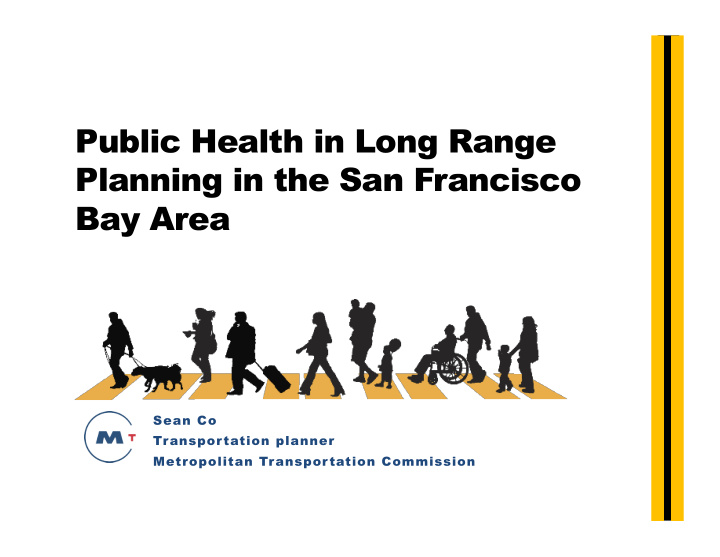



Public Health in Long Range Planning in the San Francisco Bay Area Sean Co Transportation planner Metropolitan Transportation Commission
Targets Adopted Targets 1. CO 2 emissions reduction 2. Adequate housing 3 a. PM 2.5 emissions reduction b. PM 10 emissions reduction Targets adopted by MTC & ABAG c. PM emissions reduction in CARE communities Smaller projects assessed by type 4. Injury and fatality collision reduction 700 projects in total analyzed 5. Increase in minutes of active transportation (walking/ biking) 6. Open space and agricultural preservation 7. Decrease in low-income expenditures on transportation 8. Economic vitality 9 a. Decrease in per-trip non-auto travel time or increase in non-auto mode share b. VMT reduction 10. State of good repair
SB 375-Sustainable Communities Strategy – Plan Bay Area Links land use and housing to transportation Designed to achieve a 15% Region must show how it can house all the CO 2 reduction population in the next 30 years per capita by 2035 Preservation of open space and agricultural land Show how development pattern and transportation network can reduce greenhouse gases
Benefit-Cost 100 projects with cost>$50 million Benefits: • Travel time • Emissions (CO 2 , PM 2.5 , PM 10 , Benefits based on MTC ROG, NOx) regional travel model runs • Health costs due to level of of each project physical activity • Collisions causing injuries, fatalities, or property damage • Direct user costs (vehicle operating/ownership) • Noise Costs include: • Capital expenditures • Net operating & maintenance expenditures
Active Transportation Target Development Where does walking and cycling fit within the 30 min/day of moderate to vigorous activity? No metrics for active No performance standards from the CDC transportation Community Guide – insufficient evidence that transportation policies increase physical activity What is the expected increase in active transportation in 30 years?
Active Transportation Target Development What portion of physical activity should transportation take credit for? Large differences in Residents within 1/2 of rail or ferry got on physical average 15.5 minutes per person per day, rest of activity levels the Bay Area 7 minutes Should all residents get the same physical activity?
Methodology of Evaluating Active Transportation Activity Based Travel Model – changes in walk, bike and walk to transit trips from each project Travel Model Minutes of each trip were calculated on calculates average trip distance and time effects of investments on trips Average bike trip distance 2.27 miles Average speed of bike trip 12 mph Average walk trip distance 0.92 miles Average speed of walk trip 3 mph
Methodology of Evaluating Active Transportation % of Active (Change in minutes/person/day) * (inactive population 62%) Individuals (Minutes to become active -30) Active Percent of active or inactive individuals individuals * from the project Projected Bay Area Population
Health Car Health Care Cost Sa e Cost Savings vings California Health Interview Survey (CHIS) – 62% of Bay Area residents are inactive $1220 Savings per Active Person Health care costs from California Center for Public Health Advocacy, - based on disease types attributable to physical inactivity Lost productivity to inactive lifestyle
( Regional Bicycle Network ) Distribution of Benefits Noise 0% Travel Time 22% Active Transportation Auto Travel Costs 53% 21% Collisions 3% PM 0% CO2 1% Other Pollutants 0%
Total Distribution of Benefits Active Transportation Other Pollutants 3% 0% Collisions Noise 3% CO2 0% PM 3% 1% Auto Travel Costs 11% Travel Time 79%
Total Benefit from Active Transportation $1.1 Billion in benefits from health care cost and lost productivity reductions Achieve Target of 15 minutes/person/day Increase of 5 minutes over base case 10.6% of Bay Area residents becoming active
Implementation One Bay Area Grant Transportation Infrastructure Investments in infill opportunity areas - Priority Development Areas (PDAs) $795 million over 4 years STP/CMAQ 70% of the grant spent in PDAs in areas greater than 1M population 50% of the grant spent in PDAs in areas less than 1M population
Next Steps Implementation of Projects Based on Public Health Impacts Common methodology for assessing health impacts in transportation projects Award of projects based on health impact What is the level of transportation investment necessary for a desired health outcome?
Sean Co Metropolitan Transportation Commission sco@mtc.ca.gov
Recommend
More recommend